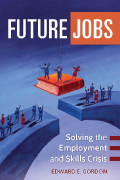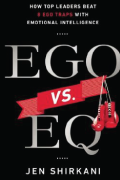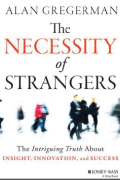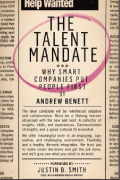TD Magazine Article
Where Are the Workers?
A review of Future Jobs: Solving the Employment and Skills Crisis by Edward E. Gordon
Sun Dec 08 2013

Future Jobs: Solving the Employment and Skills Crisis
By Edward E. Gordon
Praeger, 203 pp., $37
For the better part of 15 years, Ed Gordon has been telling us in his well-researched, inimitable style that we are on our way to an employment and skills crisis. The skills gap that's been growing for three decades has accelerated during the Great Recession. Companies—in fact, entire industries—are not doing what's needed to bridge the gap.
The statistics are grim. The U.S. Census Bureau reports that, in 2009, 10.9 percent of Americans held a technical or career certificate, 8.2 percent held an associate's degree, 17.1 percent held a bachelor's degree, and 9.2 percent held an advanced degree. Another statistic shows that 850 students drop out of school every hour of every day of the year.
To quote Gordon, "In 2013, over 89 million Americans of working age were not part of the U.S. labor market. The number of people looking for work (the labor oxidant rate) was near the historic low of 63.6 percent, while the average duration of unemployment remained at near-historic highs. Why are so many Americans sitting on the job sidelines, while over six million jobs are vacant across the U.S.?"
Gordon tells readers we have to move from talent management to talent creation. He explains which careers are growing in the next 10 years, and how individuals can determine which career paths best suit them. This is great information for career development professionals as well.
There is an entire chapter aimed at corporate training. Gordon describes the concerns expressed by managers that training is ineffective. Much of the reason, he says, is because the training provided by many companies is too generic (the learning methods chosen don't fit the employees, the learning objectives, or the organizational culture) and what is learned is rarely reinforced on a day-to-day basis through manager interaction and the performance appraisal system. Many readily implementable ideas are here for the taking, including how to take advantage of IRS rulings on capitalizing training costs and how to measure your training return-on-investment.
The author shows readers how we can easily accomplish the changes we need to make in our recruiting and training efforts. He proposes using the Regional Job Talent Innovation Networks (RETAINs). Started in the 1990s, RETAINs originally were designed for economic, school, and tax reform. Now they can be the key to rebuilding the jobs pipeline regionally because they create a structure for businesses, students, teachers, workers, and government to collaborate.
The book gives detailed descriptions of organizations that are using RETAINs to fix the employment and skills crisis so we can replicate what they've done. Gordon also includes a list of websites where readers can learn more and even contact people who can help them create the same programs in their areas.
Ego vs. EQ: How Top Leaders Beat 8 Ego Traps With Emotional Intelligence

Jen Shirkani
biblio_motion_ books + media, 185 pp., $27.95
Society is rife with brilliant leaders who excel technically but fail catastrophically when it comes to interpersonal skills. Shirkani chalks this up to lack of emotional intelligence (EQ). In this book, she shows how EQ can be used as a tool to beat back ego—the quality that, when left unchecked, is most detrimental to effective leadership. Drawing on her experience as an executive coach, Shirkani explains how to overcome eight common ego traps that leaders fall into, including ignoring feedback, dismissing people whose perspectives and backgrounds are too different from their own, having excessive control, and forgetting how their actions affect workers down the line.
The Necessity of Strangers: The Intriguing Truth About Insight, Innovation, and Success

Alan Gregerman
Jossey-Bass, 224 pp., $26.95
When we build our networks, we usually seek to include people with the usual experience and accomplishments: senior leaders, successful entrepreneurs, thought leaders, and so forth. Or, we routinely trade ideas with peers or close friends. But we may be shutting out a powerful group of contacts: strangers. In The Necessity of Strangers, Gregerman argues that engaging with strangers who are quite different from us can result in innovative thinking and creative problem-solving—and it also builds our self-awareness. The author presents a practical guide to meeting and learning from strangers, gleaning from their perspectives and experiences the insights we need to energize our workplaces, improving collaboration, generating better ideas, and building stronger customer relationships.
The Talent Mandate: Why Smart Companies Put People First

Andrew Benett
Palgrave Macmillan, 242 pp., $28
People are the single most important asset of any company. Yet when it comes to talent management, many organizations are just going through the motions. Benett, global president of ad agency Havas Worldwide, set out to discover how leading companies do talent management differently. The Talent Mandate features extensive interviews with talent-driven organizations—such as Zappos, DreamWorks Animation, Nestlé, and Dow Chemical—which examine the trends that are affecting talent management today and show readers how to build strategies for cultivating talent intelligently.
What's on Peter Krembs's Bookshelf?
Boundaries for Leaders: Results, Relationships, and Being Ridiculously in Charge by Henry Cloud. This book speaks to both why we need boundaries (for focus and accountability) and also how holding boundaries too tightly makes lateral relationship-building, trust, and peer accountability difficult. One important insight in the book: When leaders are thinking about the structure and the culture they are wanting to build, "You get what you create, AND what you allow."
Immunity to Change: How to Overcome It and Unlock the Potential in Yourself and Your Organization by Robert Kegan and Lisa Laskow Lahey. Kegan and Lahey bring deeper insight into what is underneath the experience of both individual and organizational change. This is not an "intervention techniques and methods" kind of book. It goes for the deeper clarity of what form resistance to change can take, and provides insights any change facilitator or leader needs to take into account.
Buddha's Brain: The Practical Neuroscience of Happiness, Love and Wisdom by Rick Hanson and Richard Mendius. This is a very practical guide to the practices that, when made habits, help leaders find calm energy and the ability to center themselves in challenging situations.
